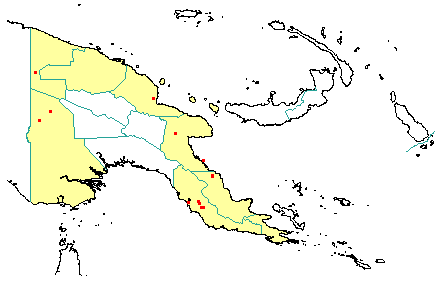
in PNGplants database
PNGTreesKey – Jagera javanica (Blume) Blume ex Kalkman |
Barry Conn (NSW) & Kipiro Damas (LAE).
Guide to trees of Papua New Guinea
Copyright held by the authors, National Herbarium of New South Wales, and Papua New Guinea National Herbarium
Blumea Vol. 7: 470 (1953)
Other Literature: P.W. Leenhouts, Flora Malesiana, Series 1 615-617 (1994) Fig. 48 (a-c).
Family: Sapindaceae
Dicotyledon
Timber Group: Non-timber species
Field Characters: Small sub-canopy tree (up to c. 15 m high, rarely to 20 m); Bole cylindrical (up to c. 30 cm diam.); straight (bole up to 5 m long); buttresses sometimes buttresses present or buttresses absent; spines spines absent; aerial roots aerial roots absent; stilt roots stilt roots absent; Bark grey, slightly rough, finely fissured; Subrhytidome (under-bark) green; less than 25 mm thick, 6.0-8.0; bark blaze consisting of one layer; faintly to non-aromatic; outer blaze white or yellow (pale (straw-coloured), markings absent; inner blaze white or yellow (pale (straw-coloured), markings absent; bark exudate (sap) present, colourless, not readily flowing (spotty), colour not changing on exposure to air, not sticky; terminal buds not enclosed by leaves.
Indumentum: Complex hairs absent; stinging hairs absent; mature twig indumentum (hairs) present, hairs dense.
Leaves: Leaves clustered at end of branches, usually whorled (with more than two leaves at one node of a branchlet), 6 (c.), compound (a leaf made up from two or more leaflets); petiole present, not winged, attached to base of leaf blade, swollen (at base); leaves pinnate (unbranched with more than three leaflets) (13-40 leaflets); petiolule not swollen; rachis present, absent, absent; leaves without a terminal leaflet (the number of leaflets even - paripinnate), broadest below middle or equally broad throughout much of length, 2.5-20.0 cm, 1.0-6.0 cm, leaflets alternate (to almost subopposite), symmetric; venation pinnate, secondary veins open, prominent, intramarginal veins absent; leaves lower surface brown or red (pale (rusty-coloured hairs), upper surface dark green, indumentum (hairs) present (on veins or all over lower surface), indumentum (hairs) dense; absent; domatia absent; stipules absent.
Flowers: Inflorescence terminal (by misinterpretation (inflorescences clustered near apex of axis) or axillary, flowers on a branched axis, cones absent; flowers bisexual, stalked (shortly (almost sessile), flowers with many planes of symmetry, 1.0-2.0 mm long, diameter small (up to10 mm diam.) (up to 2 mm diam.); perianth present, with distinct sepals and petals whorls, inner perianth white or pink; 5, free; stamens 8 (c.), present, free of each other; ovary superior, carpels joined (when more than one), locules 3; styles solitary, 1.
Fruits: Infrutescence arranged on branched axis, fruit 20.0-25.0 mm long, green, red, or brown (with rusty-coloured hairs), not spiny, non-fleshy, simple, dehiscent, capsule.
Distribution: West Sepik, East Sepik, Madang, Morobe, Western, Central, Northern & Milne Bay.
 | Botanical records in PNGplants database |
Notes: Notes Two subspecies are recognised. Jagera javanica subsp. javanica occurs in Papua New Guinea, whereas, subsp. australiana Leenh. is restricted to northern Australia.